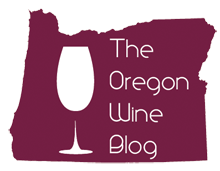Over the summer the Corvallis office of The Oregon Wine Blog combined cycling and wine to bring you the
Tour De Vino. Now it's Autumn in the Pacific Northwest and for me, that means its
cyclocross season. I asked myself if was possible to combine two of my favorite things: cyclocross and wine tasting. I even (briefly) considered installing 40cm barriers between the wine and the party guests, though I decided not to as it would leave serious marks in the hardwood. Similarly, I dismissed the idea of bringing mud or a sand feature into the house due to prohibitively unpleasant cleanup.
Instead I decided to fashion the tasting after
Cross Clash.

Cross Clash is the annual battle between the two Northwest cyclocross powerhouses: Seattle meets Portland, Sasquatch versus the Unicorn, Washington against Oregon. I have no idea why a unicorn Portland is represented by a unicorn. If you have insight, please share in the comments.
I decided to send a call out to some friends. I asked them to bring their favorite bottle under (but near) $25 from their favorite wine-producing state. Cycling around (HA!) to the racing analogy, this would put the wine squarely at the Category 3 level. (Category or “Cat” 4 racers are beginners, and Cat 1 and 2 is your elite racing crowd of pros and very advanced amateurs.)
To have a little more fun and to ensure fair play, we decided to do the tasting blind. In Cross Clash scoring is based on the order the racers finish, with their state receiving their points. The higher the finish, the higher the points. The points are added together to determine the winning state. Prior to our ‘race’ it was clear there was some serious provincialism going on. Calls of "Hey, how's it feel to pay sales tax, loser?" and "You guys don't know how to pump your own gas?" were commonplace. This vitriol left me with doubts about objective judging the wines and reinforced the decision to do the tasting blind.
Gwynne set up a score sheet for each participant; they subjectively scored the wines based strictly on what they liked. They were asked to consider the palate, color and nose of the wine and give them a number score. The scores were totaled and a winner was declared. It came out Washington, in an echo of the Cross Clash outcome. But wait, there was a catch.
Anyone who has raced will tell you there is always a sandbagger. A "sandbagger" is a racer who has shown up looking for an easy victory. Like a pool hustler, the sandbagger is racing against guys that's he's guaranteed to beat, because the sandbagger hasn't upgrade his race category. He's often a Cat 3 racer riding against the 4s. We definitely had a Cat 2 racer mixing it up with the 3s and it came out in the results.
The consensus winner was the
Buty Columbia Rediviva 2006 ($48), a delicious blend of cabernet and syrah. This wine was smoother than all the others, and had a structure and finish that belied the sandbagger it was. It was clearly in a class of its own. Let me say that if you haven't had any of the Buty wines, what are you waiting for? This is their top dog, and it shows. Three years in the cellar before release has turned out an incredible wine.
While there was a clear winner, no one was lapped. The other wines were able to hang with our "cheater." While there was some debate, the next two favorites were Bookwalter’s Subplot 23 and Seven Hill’s Merlot. Gwynne and I picked up the
J. Bookwalter Subplot #23 ($20) at the Woodinville tasting room, and it's an amazing wine. The lighter spice on the palate and the cherry and wood nose are very enjoyable, and Gwynne was captivated by the taste of butterscotch in a red wine. Close on its heels was the
Seven Hills Merlot, Columbia Valley ($20). With tones of oak and rounded spices, this wine had one of the favorite noses of the evening.
From Oregon, we had two Pinots that fared well.
next: ($18) a wine made by King Estates, was very smooth, though it didn't initially show complexity. The wine had a great balance, and was unanimously described as "a wine I could drink all day," which was the goal when King Estates made it. We were all a bit perplexed by the label, and I found the silly quote on the back a bit over the top.
The Sharecropper's Pinot Noir, from
Owen Roe ($24) was more nuanced than next: and showed some of the craftsmanship of those master Oregonians. Another everyday drinking pinot that had hints of red and black fruits.
The wildcard of the evening was the 2003 Marachel Foche from
August Cellars. This wine is a wild one, and has been a favorite of ours, and a reason to visit the folks at August Cellars almost annually. The Foche had the most pronounced nose of the evening, which everyone found intriguing, but many folks weren't up for the palate of forest floor, mushrooms, and wild, wild fruit.
So this year's Cross Clash winner was also this year's Cork Clash winner. But there was foul play afoot. We're doing it again next Autumn, giving Oregon a shot at revenge. Send your recommendations or have your own Cork Clash. While you’re at it, be sure to check out a cyclocross race near you, the
US Gran Prix of Cyclocross will be in Portland on December 5th and 6th.
































